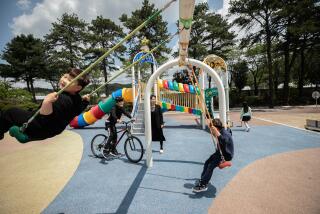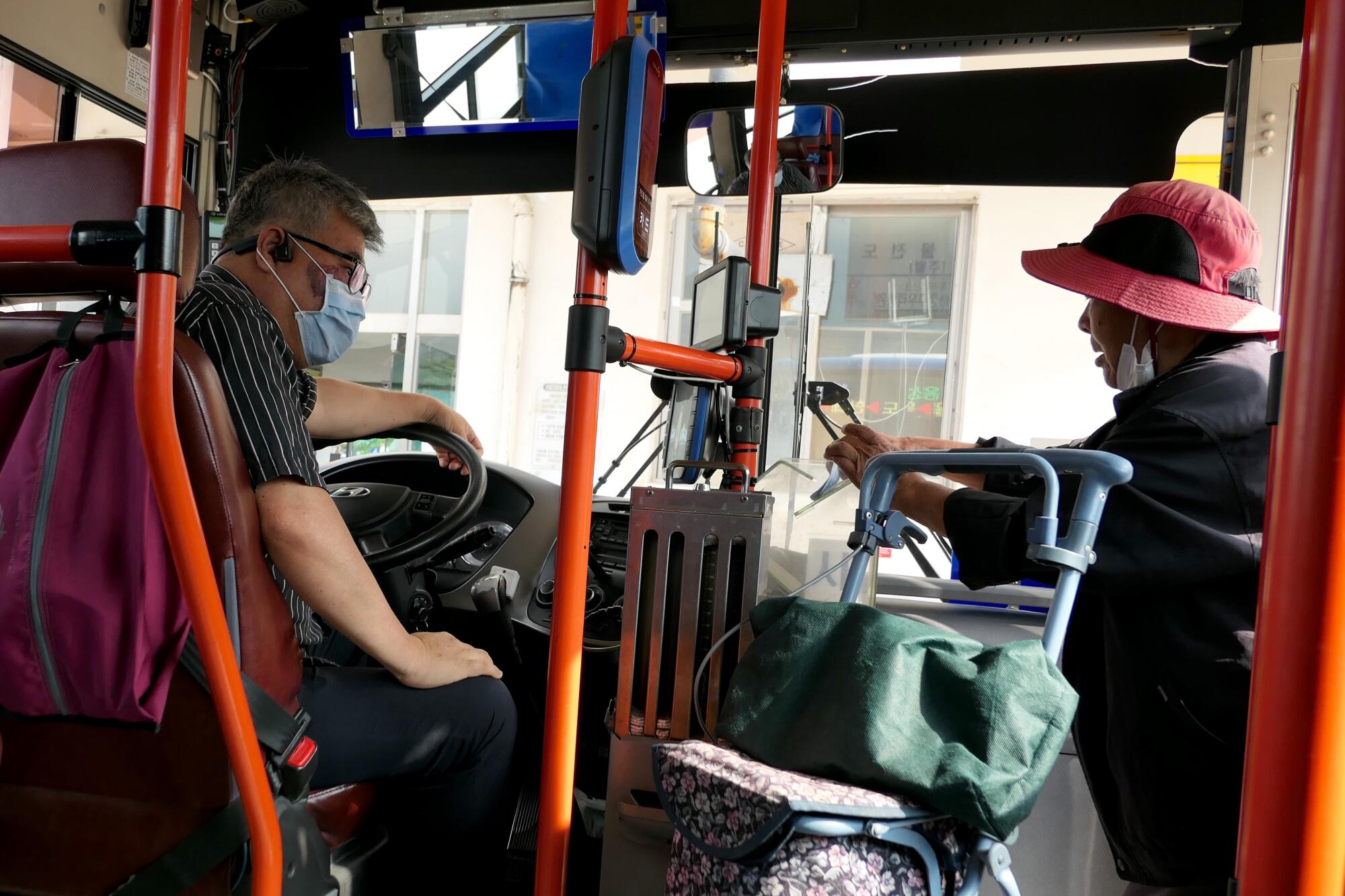
- Share via
GOESAN-GUN, South Korea — All day long, Han Kwi-young’s eyes dart from the road ahead to the rearview mirror reflecting the inside of bus No. 106-1.
“Have a seat!” he intermittently bellows in his baritone. “Don’t get up until the bus stops!” He knows the fragile bones of his charge — uhreoshin, or elders, as he usually addresses them — pose far more peril than any hazards on these rural roads winding between rice paddies and fields of corn, tobacco and peppers.
The villages along his route are small, and getting smaller. A dozen households in one, a handful in the next, mostly populated by elderly residents whose children have long since left for the city. Every few months, a face disappears among his regular riders, and Han figures they’ve moved to a nursing home or died.
Goesan-gun, where Han began driving a bus three years ago, is perched on the knife-edge of South Korea’s demographic decline. Even in a country with the lowest birthrate in the world, where last year deaths outnumbered births by 33,000, Goesan stands out as one of the regions highest at risk of fading out of existence.
In these remote parts, the bus that comes by once every couple of hours is a meeting place, an escape, a lifeline for the elderly whose steps falter, who pay the fare in crumpled bills and can’t always hear Han’s commands — or choose not to.
A city boy raised in the capital, Seoul, Han followed his own meandering path from selling lead frames to farming shiitake mushrooms to the driver’s seat of this rural bus. He finds himself something of a cross between a social worker, a chaperone and an accidental ethnographer bearing witness to a community in a quiet existential fight.
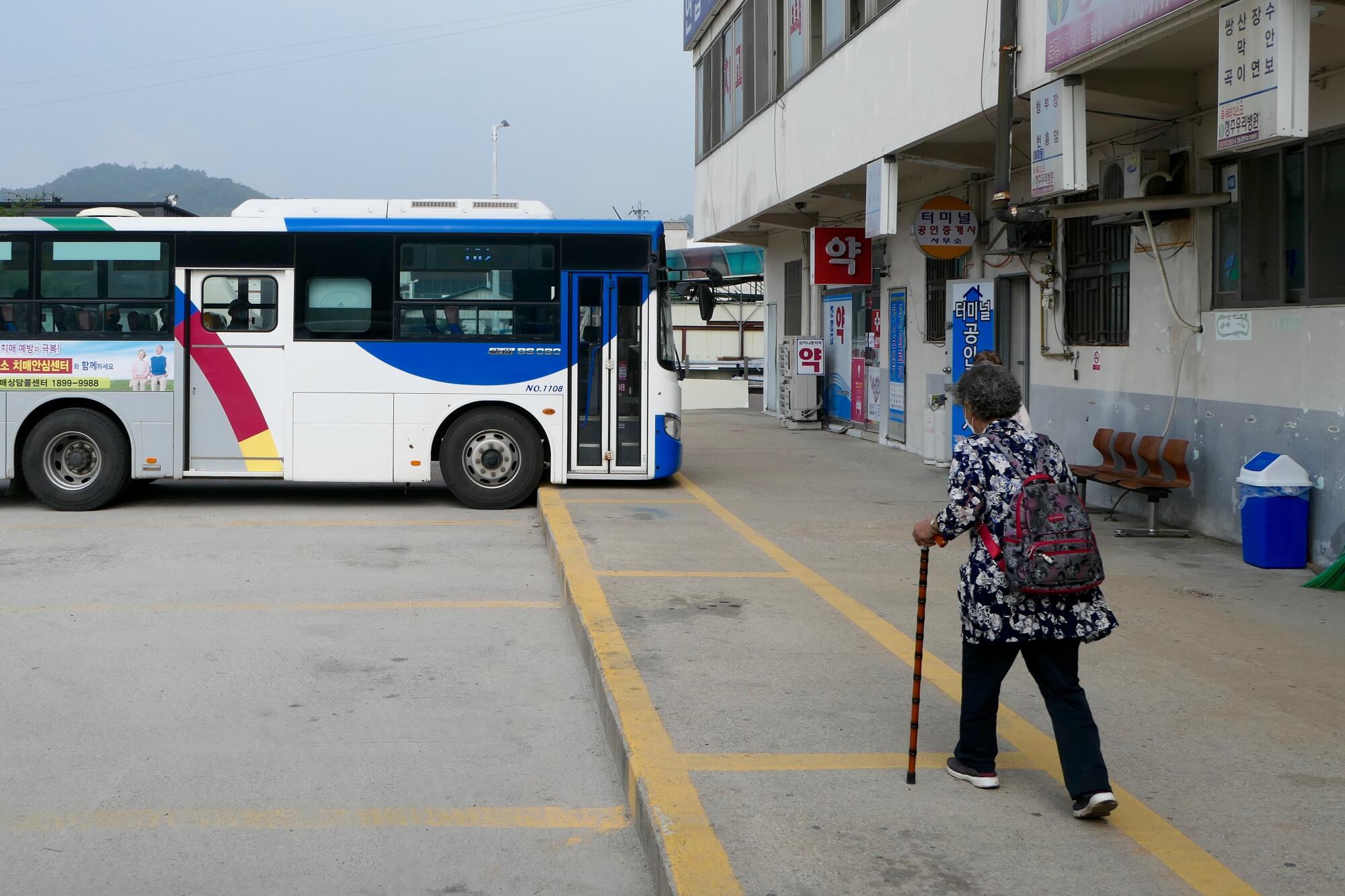
The bus depot Han takes off from at 7 a.m. on the dot says a lot about those he serves. The faded two-story building houses a pharmacy, an orthopedist and a medical goods store advertising in big block letters its selection of hearing aids and “adult diapers.”
Han is a precise man with a strict schedule, but throughout the day, time inevitably warps around the cadence of his aging ridership. Many need extra time to ascend and descend the three steps on and off his bus, and when he sees someone rushing to get to a stop, he slows — missing one bus could mean a couple of hours’ extra wait. Then there are the occasional bags of produce he ends up helping load and unload, like the sack of sesame in need of pressing for oil that he recently discovered was inordinately heavy.
That picture of a graying, dwindling population is far from unique to Goesan, a farming town that once attempted to get in the Guinness World Records — unsuccessfully — by building a 43.5-ton iron rice pot that could feed its 40,000 residents. Its population had fallen from a high of more than 160,000 in the 1960s due to attrition and aging, and also after part of it was split off into another municipality.
According to the Korea Employment Information Service, which has been keeping track of regions at “risk of extinction” based on the proportion of the population over 65 compared with women of child-bearing age, nearly half of South Korea’s municipalities are in danger of fizzling out. More than a third of Goesan’s population is older than 65; in 1990, that age group made up less than 10%.
Despite pouring tens of billions of dollars annually in recent years into policies aimed at encouraging South Koreans to reproduce, the country has been unable to slow the birthrate decline, much less reverse it. Last year, its population shrank for the first time in history.
The country’s fertility rate in 2019 was just 0.92, far shy of the 2.1 “replacement rate” of babies per woman needed to keep a population steady. The U.S. and China have fertility rates around 1.7 but are also trending downward, raising alarm that similar demographic crises are not far off for the world’s biggest powers and economies.
Han, a staunchly built 57-year-old with salt-and-pepper hair who carries a Richard Dawkins tome to read on his breaks, glimpses signs of what’s to come through his windshield and in his rearview.
“A stop where five people used to get on, it becomes four, then three,” he said.
On a recent foggy morning, elderly women with tan, grooved faces from decades in the fields and the tightly curled coif of choice of their generation boarded Han’s bus and began chatting away with the excited buzz of children on a school bus. Most had recently gotten their second COVID-19 vaccine shot, and they debated when it would feel right to go mask-free.
Without children, it becomes a dead village, an extremely lonely village
— Han Seog-ho, 63
“Where are you off to?” an 84-year-old asked a friend from a few villages down the road she only sees when they happen to meet on the bus. They hadn’t seen each other in months.
“The hospital, where else?” replied the friend, decked out in a pearl necklace.
Public health researchers in the U.S. and U.K. have found that the availability of bus services can have an effect on depression risk among the elderly people living in those communities. When a passenger begins talking his ear off, Han nods along, knowing the person probably lives alone and may have gone days without talking to another human being.
“Buses here are like blood vessels, connecting people to people,” he said. Without them, villages would die off, “like flesh cut off from circulation.”

An engineer by training, Han discovered soon after starting as a driver that much about rural bus service defies the basic rules of efficiency or economics. Most routes don’t take the shortest distance between two places but instead take circuitous back roads and weave in and out of villages, requiring the hairiest of U-turns, in order to service a patchwork of towns tucked between mountains and streams.
He does the math in his head of the gas his 6,000-cubic-centimeter engine is burning and the 1,500 won — about $1.30 — bus fare that each ride brings in. He can go hours without a passenger, and at times, even a full day. Most rural bus services would not survive without heavy government subsidies.
“There’s nothing more inhumane than efficiency,” he said.
His days are a study of a generation in its sunset years. The woman who couldn’t read the bus timetable because she was kept home to work in the fields while her brothers went to school. The sheepish twilight courtship of gentlemen insisting on paying the bus fare of pretty grannies. And, occasionally, accidents born of the combination of a speed bump and weakening bladder control that have taught him there’s nothing better than bug spray as a quick fix to mask the odor on the seats.
It took Park Ok-yeol, 88, three bus rides on a recent Monday to make her way from her home in Cheongcheon-myeon to a nearby city, Chungju. She had a question about the cost of her medication at the local veterans’ affairs office, through which she receives survivors’ benefits because her husband fought in the Korean War.
From her home, where she’s lived alone since her husband passed away 12 years ago, she caught the first bus to come through her town a little after 7 a.m. By midafternoon, she was still slowly making her way back home, asking bus drivers about which buses would get her back, sipping on a carton of soy milk from her cat-patterned knapsack in lieu of lunch.
There used to be six buses a day; now it’s three or four, she said.
“When I venture out, I run into people I know,” she said. “Without buses I’d never get out.”
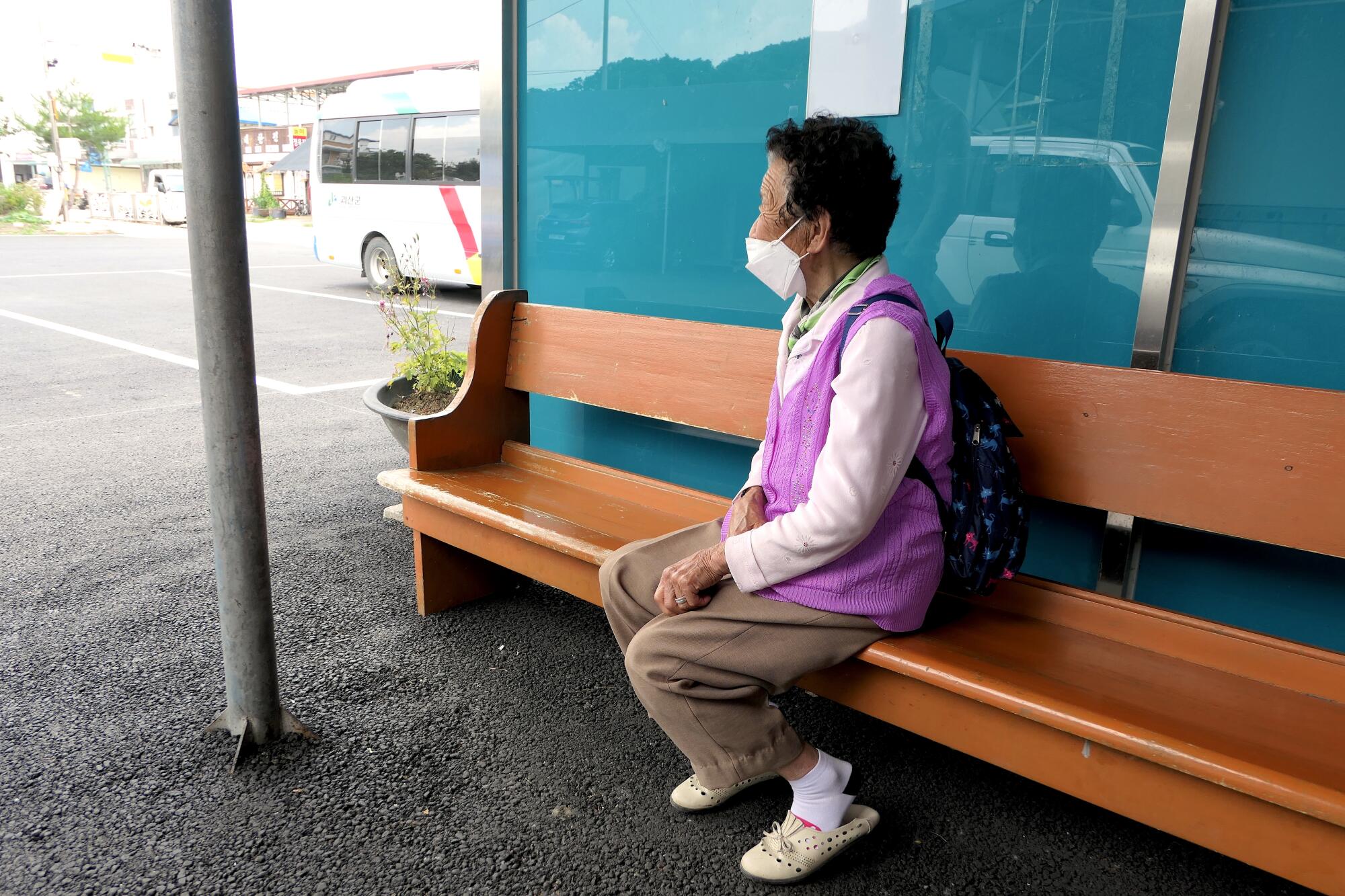
Children are scarce; playgrounds and schoolyards often sit empty. There are more shuttered schools in the district than open ones. Han’s bus route takes him past Mokdo High School, one of two high schools in Goesan that’s slated to close next year after the final class of 20 students graduates.
Nearby Baekbong Elementary School had zero first-graders enroll in 2018. It was a candidate for closure, but alumni and nearby residents formed an emergency committee to save the school, huddling in the cafeteria in the evenings.
“Without children, it becomes a dead village, an extremely lonely village,” said 63-year-old Han Seog-ho (no relation to the bus driver), who went to Baekbong in the 1960s when there were more than 1,000 students. “It means there’s no hope of a future.”
He and others hatched a plan to build a dozen apartment units across the street from the school, offering them up rent-free for families with elementary school-age children. The enrollment has nearly doubled since — 22 of the school’s 37 students are from families that have newly moved in. The local government is planning on building similar housing around the region to entice young families.
Whether they’ll put down roots and stay beyond the children’s years in school is uncertain. Many are mothers and their children, with fathers staying in the city for work. The free housing doesn’t solve the underlying issues of a lack of jobs, educational opportunities or cultural amenities.
“It happens so quickly,” said Vice Principal Park Gyoung-ock, who grew up in a different part of the province and saw the changes throughout her lifetime. “The wedding halls and obstetricians disappear, and adult day-care centers and nursing homes take their place.”
A fellow driver of Han’s, 56-year-old Lee Byung-tae, grew up in Goesan and came back after 34 years to find his native village a skeleton of what it was when he was a boy.
“There are empty houses everywhere you look,” he said. “It’s all shrinking to nothing.”
Lee’s bus route takes him past a closed school that for a while was used as a dorm for foreign exchange students at a university in town, which has its own problems having fallen 448 students short of its class size this year. The pandemic has kept the exchange students away, and now, he glanced over at the deserted schoolyard from the road to see it overgrown with weeds as tall as he.
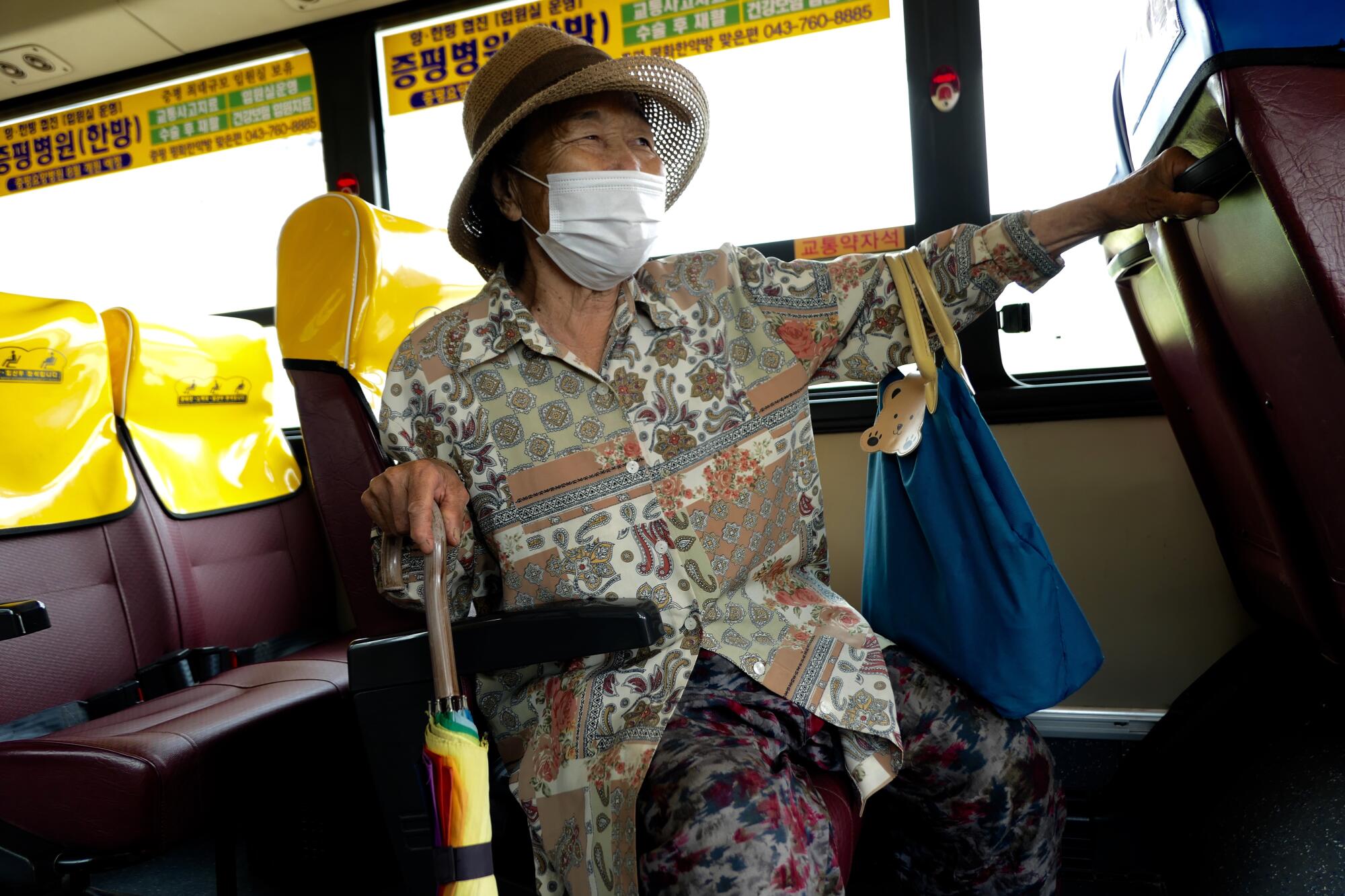
Lee Soon-bok, 83, climbed aboard clutching a rainbow-colored umbrella she uses to steady herself because she’s too proud to tote a cane. She took Han’s first bus into town to see the doctor about the aches and pains in her leg and back. A couple of hours later, he again greeted her on her way home.
She’s rare among her contemporaries in that her son, the eldest of four, has remained in her village to take over the family’s apple orchard. His son too has stuck around to work on the farm.
Children had long since disappeared from her church, which has dwindled to a dozen people from the 30 to 40 that once gathered. Even so, she felt optimistic about her modest hamlet.
“You hear orioles in the mountains behind us, and a stream runs through,” she said. “And the transportation is great.”
For his last run of the day, Han often finds himself alone for the ride. Most of his elderly clientele run their errands early, leaving him alone to mull over life, mortality, family.
He’ll blast Queen or Pet Shop Boys and ride into the sun lingering on the horizon, his rattling bus coasting between a colonnade of ginkgo trees.
More to Read
Sign up for Essential California
The most important California stories and recommendations in your inbox every morning.
You may occasionally receive promotional content from the Los Angeles Times.

